Pleasley Vale St ChadFeatures and Fittings
Altar
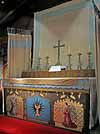 The altar is of timber, carved but covered to the front with a painted panel. The gradine has a carved timber frontpiece with carvings depicting fruit, leaves and cereals. The altar is of timber, carved but covered to the front with a painted panel. The gradine has a carved timber frontpiece with carvings depicting fruit, leaves and cereals.
The painted panel in front of the altar (but not fixed to it) has three sections depicting in the centre a chalice on a blue diamond background with kneeling archangels to the left and right.
Altar rail
A simple timber single rail mounted on wrought iron decorative support. A sliding centre piece allows the rail to be continuous across the altar area.
Sanctuary panelling
 The sanctuary The sanctuary |
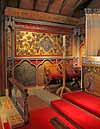 Panelling on Panelling on
the north |
 Detail Detail |
 Panel on west wall Panel on west wall
to north of altar |
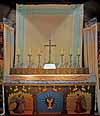 Altar Altar |
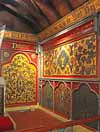 Panelling on Panelling on
the south |
 Detail Detail |
 Detail of panel on Detail of panel on
south wall of sanctuary |
The whole of the sanctuary area has highly decorated carved timber panelling. The top panels appear to be oil paint on canvas with lower panels painted on timber board.
Across the top of the panels is the inscription: ‘Whoso eateth MY FLESH and drinketh MY BLOOD hath ETERNAL LIFE and I will raise him up at the Last Day’
On the panel to the left of the altar ‘GLORIA TIBI’ and to the right of the altar ‘DOMINI’ which together translates as ‘Glory be to Thee, O Lord.’
On the same panels (beneath the text) are four small roundels depicting the symbols of Matthew, Mark, Luke and John.
Chancel Screen
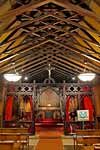 Chancel screen Chancel screen |
A carved timber screen, with traceried panels and rood, separates the nave area from the chancel.
Pews and Choir Stalls
Most of the original pews have been removed from the nave, to be replaced by individual wooden chairs. The four pews in the choir and the two pews at the west end of the nave remain. The design is attributable to Pugin, but more accurately should be described as being in the style of Pugin.
There are three individual chairs with x-frame legs. These are a version of the Glastonbury chair, to a design by Augustus Welby Pugin (1812-1852). The original version by Pugin was made 1839-41 and was a design based upon a folding chair with x-frame legs, said to have belonged to the last Abbot of Glastonbury. Many different versions of the Glastonbury chair, sometimes carved with decorations and inscriptions, were made by firms such as Gillows & Co and Cox & Sons for both institutional and domestic use in the nineteenth century.
Cox and Sons of the Strand, London are said to have been responsible for the design of the church and its fittings. They were founded in 1838 by Thomas Cox and over the next 40 years the firm became one of the leading church furnishing companies. By 1870 a catalogue of Cox & Sons claimed to be able to supply 800 designs of furniture, Gothic metalwork, carpets and hangings by ‘eminent church designers’.
Font
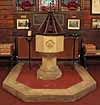 There is an octagonal font in stone mounted on a stone plinth. It is of simple design with a wooden cover. There is an octagonal font in stone mounted on a stone plinth. It is of simple design with a wooden cover.
Pulpit
The pulpit has been removed. The Listing Description states it was a 'wrought iron skeleton pulpit with C20 infill panels.'
Lectern
 There is a wrought iron lectern in the nave with timber reading slope. There is a wrought iron lectern in the nave with timber reading slope.
Iron vase stand
In the nave is a wrought iron decorative stand for a flower vase with a plaque that reads:
IN MEMORY
OF
NELLIE MARSTON
1977 |
Stations of the Cross
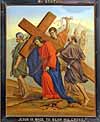 Station II Station II |
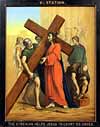 Station V Station V |
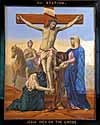 Station XII Station XII |
 Station XIV Station XIV |
14 panels depicting the 14 Stations of the Cross, set around the walls of the nave, each approximately 18” wide x 24” high. Each of the pictures has a small wooden cross above the frame.
The Stations of the Cross are:
I. |
JESUS IS CONDEMNED TO DEATH |
II. |
JESUS IS MADE TO BEAR HIS CROSS |
III. |
JESUS FALLS THE FIRST TIME UNDER HIS CROSS |
IV. |
JESUS IS MET BE HIS AFFLICTED MOTHER |
V. |
THE CYRENIAN HELPS JESUS TO CARRY HIS CROSS |
VI. |
VERONICA WIPES THE FACE OF JESUS |
VII. |
JESUS FALLS THE SECOND TIME UNDER THE CROSS |
VIII. |
THE WOMEN OF JERUSALEM WEEP FOR JESUS |
IX. |
JESUS FALLS THE THIRD TIME UNDER THE CROSS |
X. |
JESUS IS STRIPT OF HIS CLOTHING |
XI. |
JESUS IS NAILED TO THE CROSS |
XII. |
JESUS DIES ON THE CROSS |
XIII. |
JESUS IS TAKEN DOWN FROM THE CROSS |
XIV. |
JESUS IS LAID IN THE SEPULCHRE |
|